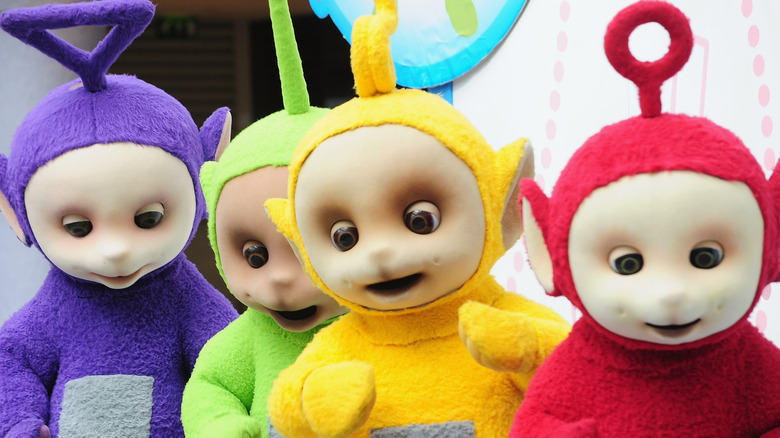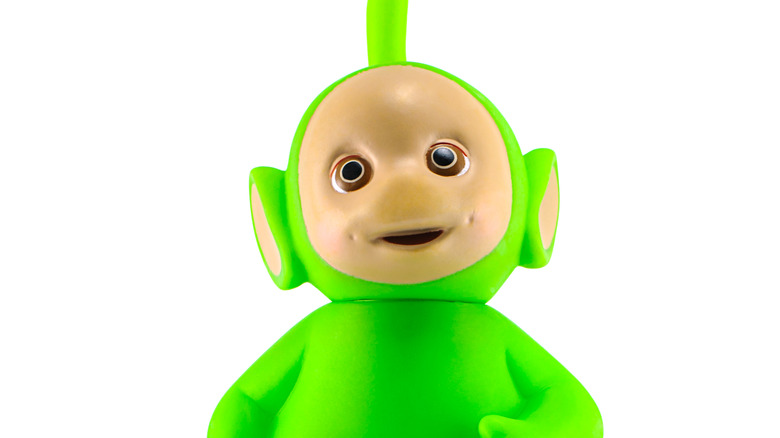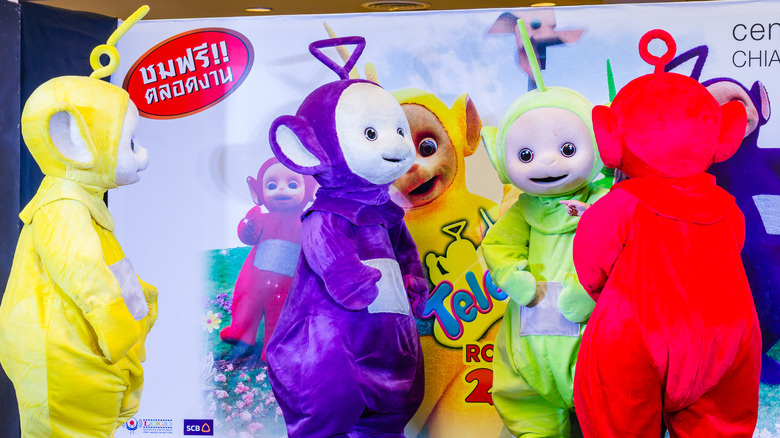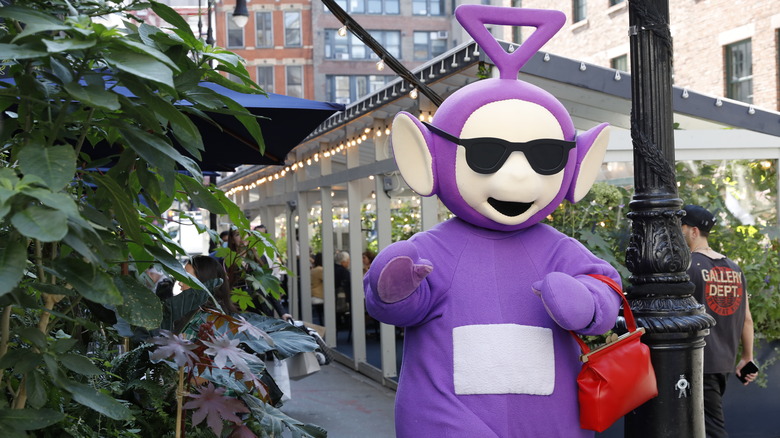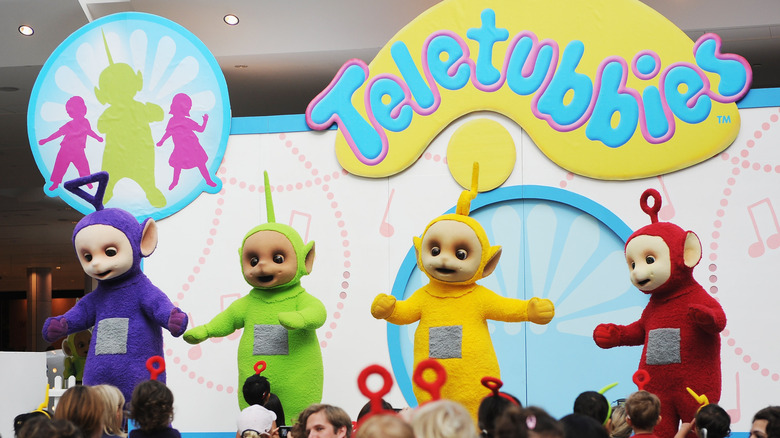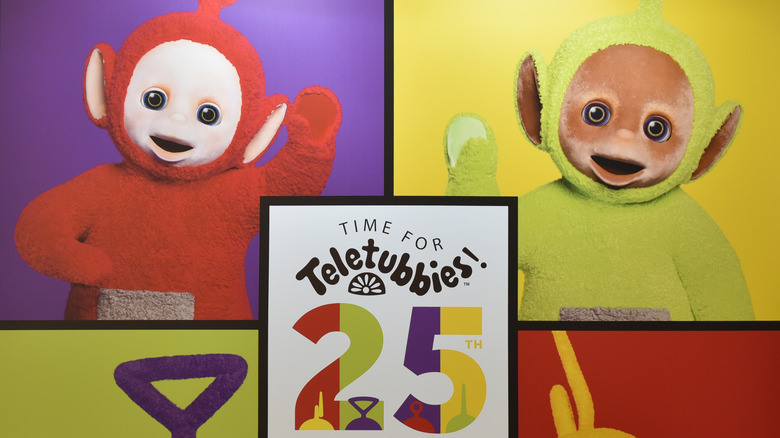What Happened To The Teletubbies?
They were icons '90s childhood. These kooky creatures, the Teletubbies, walked as awkwardly as little kids, spoke an indecipherable language, and liked to repeat segments of their television show in the same way that children like to demand repeat showings. In other words, they acted very similarly to toddlers to appeal to a preschool audience.
And they succeeded. Toddlers became immersed in the world of Teletubbyland, the grassy field where Teletubbies lived and played. While some parents were disturbed by the show (per Variety), young kids couldn't get enough of the four Teletubbies: the purple Tinky Winky, the red Po, the green Dipsy, and the yellow Laa-Laa. "Teletubbies" originally ran from 1997 to 2001, but its influence had staying power, lingering in reruns and videotapes for years to come.
History of the Teletubbies
"Teletubbies" was created by Anne Wood and Andrew Davenport (via Britannica). The first episode aired on March 31, 1997 (per BBC), and it first aired in the United States in 1998. Alice Cahn, the children's programming consultant who was responsible for bringing the Teletubbies to the screens of American children, said she found the show very unique when she first saw it. "I was amazed," Cahn told NPR of her first impression of the show. "I've been watching children's television and programming children's television since it was radio. And to see the bucolic 'Teletubbies' landscape and those wonderful characters, I had never seen anything like it."
The show would continue its original run for four years until 2001. During this period, 365 episodes were created, and they were eventually released in over 120 countries. The series was also "translated" into many different languages — at least insomuch as Teletubby gibberish could be translated.
Psychologists' takes on the Teletubbies
While kids loved the Teletubbies, response from adults was more mixed. Some parents were among those who were weirded out by the alien creatures, and others have suggested that they look like the mutant murderers from "The Brood." Elsewhere, child psychologists were worried about the effect that "Teletubbies" might have on the minds of fragile children. Some thought that the TVs embedded in Teletubbies' chests might encourage kids to become too attached to their own televisions (per Variety). Others said the gibberish way that Teletubbies spoke was unhealthy for young kids to hear (via Britannica).
But the creators behind the show defended their choices. Andrew Davenport, one of the creators behind the show, said in an interview (via Bhekisisa), "For me, Teletubbies is entirely around that early stage of life when the child is coming to grips with their own body and their own physicality: walking, talking, running, falling over — all of the things that the Teletubbies did." According to the show's producers, the show was intended to encourage kids to engage with the world.
Political controversies of the Teletubbies
The Teletubbies had political controversies, too, including one spearheaded by Jerry Falwell, an American televangelist (via Britannica). Falwell raised concerns that one of the Teletubbies, Tinky Winky, was gay-coded. As evidence, he pointed to the color of the Teletubby — it was purple — and the fact that its antennae were shaped into a triangle, a shape that has historically been linked to the LGBTQ+ community. The character also sometimes carried a purse. For Falwell, all this evidence added up, and he wrote an article in 1999 about the issue titled "Parents Alert: Tinky Winky Comes Out of Closet," saying that the character was harmful to children (via Slate).
The accusation was met with alarm by some and derision by others. Many commentators mocked Falwell for the accusation and for caring about the potential coding of a Teletubby. For their part, a spokesperson on behalf of 'Teletubbies' pointed out that the Teletubbies don't have genitals, according to Slate.
What happened to the Teletubbies after 2001?
But though the Tinky Winky accusations form perhaps the most memorable controversy surrounding the Teletubbies, they didn't push the show off the air. In fact, though new episodes of the original series ceased production in 2001, a new show, "Teletubbies Everywhere," came out in 2002. It ran for a couple of years before it, too, went off the air, but still, that wasn't the last of "Teletubbies" — the show continued to air on American TV station PBS until 2008 (via Slate), and the show was rebooted in 2015 (via Britannica).
The reboot, which released new episodes until 2018, was welcomed by some who had grown up on the Teletubbies themselves (via The Guardian). The show also added new features to the Teletubby universe, including a talking smartphone and new baby Teletubbies. These babies, called Tiddlytubbies, appeal to an even younger demographic than the show itself.
Where are the Teletubbies now?
Today, the Teletubbies still aren't entirely gone. As of 2018, yet another new Teletubby show has been released — an animated series following the Tiddlytubbies introduced in 2015 (via Britannica). As of 2015, the BBC still aired the original series in the U.K. (via The Guardian), and 65 million monthly viewers check out YouTube videos of the Teletubbies online. Nostalgic appeals via "where are they now" posts often pop up as well, especially posts about the growth of the Teletubby sun baby (via USA Today).
While it remains to be seen whether there will be any more Teletubby shows in the future or whether the 2015 or 2018 series will have the lasting power of the original run, it's undeniable that the Teletubbies remains impressed in the psyches of a generation (via the Daily Mirror). And with its many episodes available for reruns, parents can probably expect to see these plump TV-human hybrids on their televisions for years to come.
